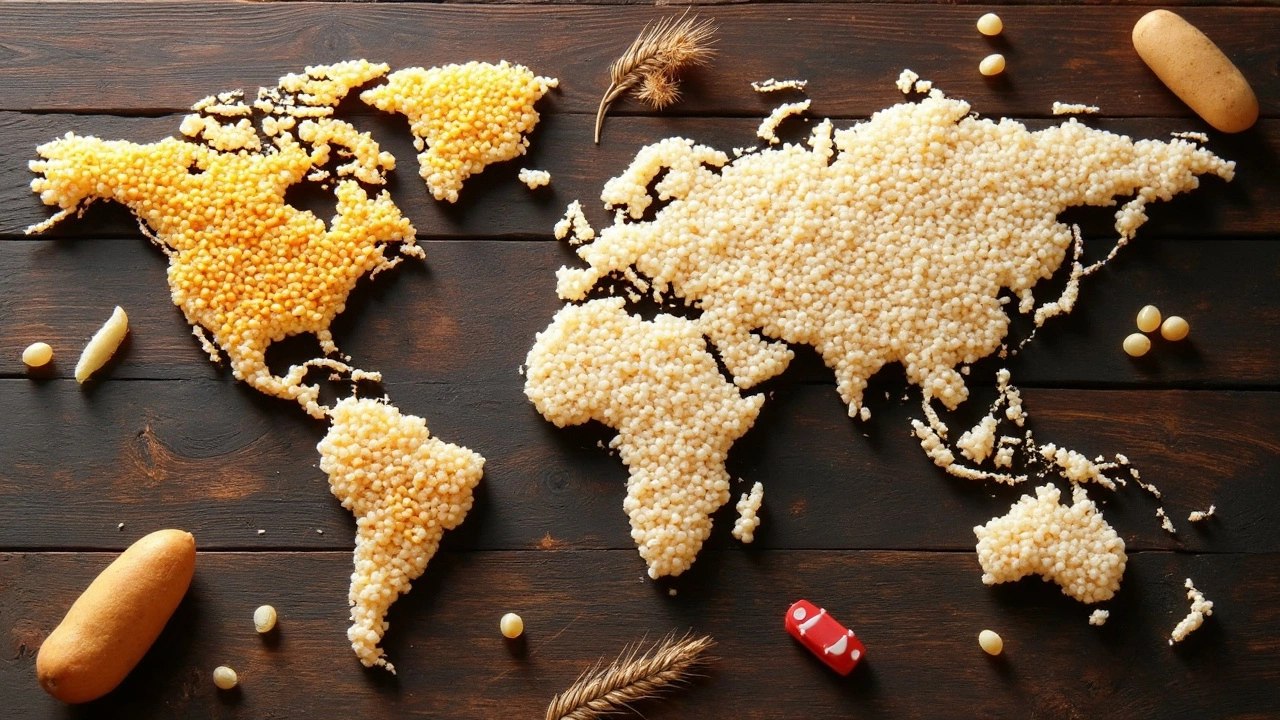If you’re the curious type, you’ve probably wondered what the world’s most eaten foods really are. Forget Instagram food trends. The most-devoured foods on earth are humble, filling, and power entire nations. I’ll let you in on a secret: nobody’s arguing whether tacos or pizza win the top spot. The answer’s a lot simpler, but maybe not what you expected. The three giants of global grub fill stomachs, wage wars, and spark culture clashes. They’re everyday foods. They’ve made and unmade empires. Their impact goes way past your pantry.
Rice: The Tiny Grain That Feeds Half the Planet
Rice may seem modest—a bowl of steamed white fluff is no mouthwatering centerpiece—but it stands at the top of the food chain, literally. This most eaten food stretches across Asia, Africa, Latin America, and beyond. Over 3.5 billion people eat rice daily, which means about half of the world’s population. In places like China and India, rice isn’t just food. It’s culture, history, and community. In Thailand or Vietnam, people greet each other by asking, “Have you eaten rice yet?” That’s how central it is to daily life. In poorer regions, rice sometimes makes up over 70% of people’s daily calories.
The stats are mind-blowing. In 2023, the world produced roughly 520 million metric tons of rice. China is the largest producer, cranking out enough to put a bowl on every table in a major city—every day. India's a close runner-up, and these two together supply more than half the planet’s rice. Even Australia, where summer rains can be dicey, has its own rice bowl region — the Riverina — showcasing how adaptable the crop really is.
Rice comes in thousands of varieties. Jasmine and Basmati are famous for their scent, Arborio for risotto, and good old Calrose is probably in your sushi roll. Each variety is tailored to regional climates and local tastes. This little grain is also pretty handy for your health: it’s gluten-free, low in fat, and quick to cook. Brown rice packs in more nutrition—fiber, magnesium, vitamins—but white rice’s soft texture runs the show in most kitchens.
There’s no one way to cook it, either. In Japan, you have sticky rice for sushi; in Italy, creamy risotto; in Nigeria, jollof rice with tangy tomatoes and chili. You can stuff it in sushi, blend it into rice milk, or whip up rice noodles for a quick stir fry.
| Region | Annual Rice Consumption Per Person (kg) |
|---|---|
| Asia | +100 |
| Africa | 24 |
| Europe | 6 |
| North America | 13 |
Ever wondered how to cook perfect rice? Simple trick: rinse well to remove extra starch, use the right water-to-rice ratio, and let it rest for a few minutes after cooking. That way you skip the mush and get fluffy grains every time. Try adding a bay leaf for fragrance, or steaming it with coconut milk for extra flavor. If you’re storing leftover rice, cool it fast and keep it in the fridge. Warm it up thoroughly before eating to avoid any nasty bacteria—food safety matters.
Wheat: The Backbone of Bread, Pasta, and Pastries
If you love toast, pizza, or noodles, thank wheat. This golden crop turns up everywhere, from your breakfast cereal to the birthday cake you grew up with. Wheat is the world’s second most eaten food, especially in Europe, North America, and large parts of the Middle East and Asia. Compare rice to wheat, and you’ll spot one big difference: wheat is the mother of many forms. It becomes flour, which means millions of food options. Every time you tear into a sandwich, munch a biscuit, or twist up some spaghetti, that’s wheat doing its thing.
The numbers are wild. Global wheat production hit almost 800 million metric tons in 2024. China, India, Russia, and the United States are the top producers. In places like Egypt, the government even subsidizes bread, which shows how vital this single food is to politics and daily life. The French? They put their cultural pride into baguettes—and got UNESCO to list the baguette as cultural heritage.
Wheat comes in different kinds. There’s hard red wheat for bread, soft white for cakes, durum for pasta. This crop has changed the landscape, literally—huge wheat fields stretch across the U.S. Midwest, Australian outback, and Ukrainian steppe. Each field feeds different food traditions: naan in India, flatbread in Turkey, ramen noodles in Japan, or damper on the Aussie trail. Some new research from 2023 suggests wheat now provides 20-25% of the world’s protein and calories.
Today, there’s a twist: ancient grains like spelt and einkorn are staging a comeback with people seeking out wholesome, less-processed foods. Sourdough and whole grain breads pack more fiber, can be easier to digest, and sometimes taste richer than your average white slice.
If you bake, here’s a tip: Different types of flour matter for your end result. Bread flour has more gluten, which traps air and gives you lofty loaves. Cake flour’s soft, so your cupcakes stay tender. Store flour in a cool, dry place with the bag sealed, or even in the fridge for extra protection from weevils, a sneaky kitchen pest. And don’t forget your pooch—my dog Rufus loves sneaking crusts from the counter, so keep those baked treats up high if you’ve got a hungry hound around.
| Top Wheat Consumers By Country (Million Tons, 2023) | |
|---|---|
| China | 137 |
| India | 105 |
| Russia | 41 |
| USA | 30 |

Potatoes: The Mighty Tuber from Andes to Everywhere
Move over, fancy roots—the humble potato is a global superstar. This starchy tuber started in South America, with the Incas growing them 7,000 years ago. They crossed oceans on Spanish ships, reached Europe in the 16th century, and then spread across the globe. Today, potatoes are everywhere: chips in England, fries in America, dumplings in Eastern Europe, and curries in India. They grow quickly, fill you up, and thrive in tough climates where other crops might fail.
The figures are huge. Global potato production in 2023 was close to 375 million metric tons, with China way out in front, followed by India, Russia, and Ukraine. The Irish might get most of the media coverage for their love of spuds, but every continent relies on them (except Antarctica, unless the penguins have started farming). In some countries, like Belarus and Poland, people eat over 180 kilograms each per year!
Potatoes, like rice, come in hundreds of varieties—waxy for salads, starchy for fries, and colorful purple or yellow ones if you’re feeling adventurous. And they’re nutrition powerhouses: packed with potassium, vitamin C, and even some fiber if you leave the skin on. They’re gluten-free, low in fat, and shockingly versatile. Boil, bake, mash, roast, fry—any way you like them, they fit in.
The potato’s story includes triumph and tragedy: it fueled Europe’s population boom but also caused famine and heartbreak in Ireland when crops failed. Today, about one in every five people on earth eats potatoes weekly, making them essential for fast food, homestyle cooking, and even vodka distilleries. New farming methods—including drought-resistant varieties—are helping spuds thrive even where climate is unpredictable.
If you want crispier fries at home, soak your cut potatoes in cold water for 30 minutes to wash away excess starch. Then dry thoroughly before frying or roasting. For healthy eating, try steaming or baking, and go easy on the butter. And if you get green patches, trim them off—those are signs of solanine, a bitter chemical that can be mildly toxic in big amounts.
| Top Potato Producers (2023, Million Tons) | |
|---|---|
| China | 95 |
| India | 53 |
| Russia | 19 |
| Ukraine | 20 |
How These Foods Shape Culture, Economy, and Daily Lives
If these top three foods sound basic, it’s because they’re simple. But their reach is enormous. Rice, wheat, and potatoes kept ancient armies fed, shaped migration and trade, and created global empires. Think about the Silk Road—without grain, merchants and soldiers never made it across those wild deserts. Or the California Gold Rush: settlers survived the trip west thanks to flour barrels in their wagons and simple potato stews.
Culturally, each food stars in festivals. Chinese New Year piles rice cakes on plates for good luck. Europe has wheat harvest festivals to mark the end of the growing season. Latin America holds potato fairs with thousands of varieties displayed on tables, side by side. These foods mean more than nutrition—they’re about faith, community, and celebration. Street vendors across Asia serve rice bowls at all hours. Arab families bake flatbreads in backyard clay ovens. Peruvian chefs create high-end potato tasting menus that pair ancient varieties with wild herbs.
On the economic front, rice, wheat, and potatoes are massive industries (worth hundreds of billions of dollars a year). Governments subsidize them, scientists create new disease-resistant and drought-tolerant types, and global prices shift with just a hint of bad weather. Farmers in Vietnam might flood their paddies for rice, while in Canada, wheat farmers obsess over rainfall and harvest timing. That scale means prices ripple from farm to supermarket and all the way into your kitchen.
Food security relies on these staples. When rice prices spiked in the late 2000s, it triggered political protests in more than a dozen countries. Potato blights or wheat shortages still cause shocks in food markets, pushing up prices on basic meals in cities as far-flung as Lagos, Cairo, or Melbourne. Urban populations are growing fast, so researchers are now working on vertical rice farms and urban wheat-greenhouse hybrids to keep up with future demand.
At home, you can stretch your budget and add variety by combining these classics. Try a wheat-flour flatbread with a spicy potato curry, or stuff leftover rice into veggie burgers. Rao’s ravioli? Potato and wheat flour. Classic shepherd’s pie? Potato topping, wheat gravy base. These ingredients are naturally flexible, cheap, and crowd-pleasing—with endless ways to mix it up.

Eating Wisely: Why Staples Matter for the Planet and Nutrition
There’s a lot of talk these days about eating local, reducing food waste, and staying healthy. Rice, wheat, and potatoes play a huge role in those conversations. Because they store well and travel efficiently, they’re eco-friendlier than lots of foods. That said, growing them uses huge amounts of land and water—something to think about when you throw away that soggy rice bowl or burnt toast. Next time, measure just what you’ll eat, and save the rest. Leftover rice becomes fried rice; bread ends make perfect croutons, and potatoes never go to waste—mash and freeze for midweek quick dinners!
From a health point of view, variety’s your friend. Mix white and brown rice, swap in sweet potatoes for regular sometimes, and choose whole grain breads for more fiber and nutrients. These small changes can help balance blood sugar, protect your gut, and pack extra vitamins in your daily food. Serve them with plenty of veggies, lean protein, and different herbs or spices, and these staples won’t ever feel boring.
In my own kitchen in Melbourne, rice, wheat, and potatoes keep things real. Rufus, my Labrador, has mastered the art of begging for toast crusts and sniffing out dropped bits of roasted potato. When I travel, I find comfort in seeing the same basic foods united by different flavors and traditions. Food connects us. So next time you eat, think about your rice, wheat, or potato—where it came from, how it shaped history, and all the new recipes you can create with just a little curiosity.

